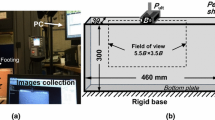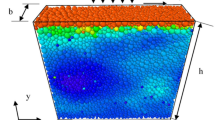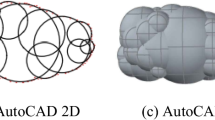Abstract
The micromechanical study of granular materials, including grain-to-grain frictional behavior and normal contact mechanics, has received great attention in the geotechnical and petroleum engineering disciplines in recent years. In this study, the results of an experimental work are presented using an advanced custom-built apparatus to explore the frictional behavior of quartz sand grains subjected to complex shearing paths. The results show that the application of pre-loading and pre-shearing affects markedly the inter-particle coefficient of friction as well as the tangential stiffness. Image analysis indicates that ploughing occurs when the shearing takes place at relatively greater normal loads, which, in turn, contributes to the observed changes in the frictional behavior of the grains in unloading. These results are promising in understanding the tribological behavior of geological materials and contribute to the more accurate modeling of the micromechanical response of soil particles.
Access provided by Autonomous University of Puebla. Download conference paper PDF
Similar content being viewed by others
Keywords
1 Introduction
The macro-scale mechanical response of soils is notably affected by their characteristics at the micro-scale. The discrete element method ‘DEM’ (after Cundall and Strack [3]) is widely used to study the complex behavior of geological materials in a micro-to-macro scale perspective. However, DEM simulations require normal and tangential contact behavior as input in the model. These input parameters widely affect the output of the numerical analysis. The grain-to-grain contact behavior plays an important role in understanding problems such as granular flows, mechanics of proppants used in hydraulic fracturing in petroleum engineering and various other geotechnical and geological applications [10, 12]. Recent advancements in experimentation helped researchers to develop inter-particle loading apparatus which can be used to study grain-to-grain contact mechanics problems in the laboratory [2, 5, 11].
Previous works by the authors [6, 7] found that the repeated shearing of quartz sand grains at greater normal loads increases the coefficient of inter-particle friction. Sandeep and Senetakis [8] reported on the inter-particle friction of various engineered and geological materials’ interfaces (with an average diameter of grains of about 2 mm). They found that the Young’s modulus and the surface roughness influence notably the inter-particle friction angle. Sandeep and Senetakis [7] investigated the effect of pre-loading and pre-shearing of grains and found significant differences in inter-particle friction with the change in load history.
In the present study, pre-loading and pre-shearing tests are conducted on Leighton Buzzard sand grain pairs, similar to the testing program conducted by Sandeep and Senetakis [7]. The custom built inter-particle loading apparatus at the City University of Hong Kong was used for the micro-mechanical testing program. A total set of five shearing tests were conducted at increasing and decreasing magnitudes of normal load to study the effect of load history on the mechanical response of the grains.
2 Materials Tested
The micro-mechanical behavior of Leighton Buzzard sand (LBS) is examined in this study. The LBS grains are of 2 mm in diameter, having consistent morphological characteristics and relatively smooth surface compared to other soils. The surface roughness of LBS grains is obtained by using the Veeco NT9300 optical surface profiler. The roughness is calculated over an area of 20 × 20 µm, and it is presented in the form of root mean square (RMS) roughness, Sq. Figure 1 shows a typical flatted 3-dimensional surface profile of LBS grains. The average value of Sq for LBS grains is 223 nm with a standard deviation of 61 nm. Senetakis et al. [11] also demonstrated that small-scale morphological characteristics of LBS grains in terms of roughness Sq are quite consistent in comparison to many other natural materials. The average value of LBS grains roughness is less, compared with other soils like decomposed granite (1341 nm) and volcanic granules (1768 nm) [8, 9]. Measuring roughness of LBS grains with optical surface profiler will always provide a small standard deviation. Thus, on the point of view of morphology, owing to the surface characteristics and composition, it can be assumed that LBS is one of the most consistent geological materials.
3 Experimental Equipment and Testing Program
A custom built inter-particle loading apparatus is used to conduct grain scale tests on pairs of grains which follow the apex-to-apex configuration [5, 10]. The image of the existing inter-particle loading apparatus along with various components is shown in Fig. 2. The apparatus consists of three loading arms in three perpendicular directions. Each arm is equipped with a stepping motor, a load cell, a non-contact displacement sensor (10−5 mm resolution) and various other mechanical parts. The soil grains are glued to the brass mounts and left to dry for a minimum of 24 h. The top and bottom mounts are placed in brass wells; one well is fixed in the vertical arm and the second one is fixed on the guiding sled of the apparatus. The whole apparatus is placed inside a Perspex chamber to control the humidity. The apparatus is suitable for testing particles ranging from 1 to 5 mm in diameter.
Figure 3 shows representative microscopic images of LBS grains in contact, showing the application of normal (FN) and tangential (FT) forces. During the application of the normal force, the top grain is lowered in a force or displacement controlled mode to achieve a contact with the lower particle at the desired normal force. In the present study, the displacement controlled mode was used for application of the normal force as well as for the conduction of the shearing tests. After reaching the required normal force, the shearing is started by moving the bottom grain horizontally at a rate of 0.08–0.10 mm/h, while the normal force is maintained constant using force controlled mode during shearing.
The micro-mechanical testing program consists of pre-loading and pre-shearing of grains. For the same set of grains, initially shearing is conducted at 1 N of normal force and the grains are unloaded. The grains are, once again, brought to the initial contact position and a normal force of 5 N is applied followed by shearing. Similarly, the grains are loaded and sheared up to 10 N of normal force. After the completion of shearing at the highest normal force, the same process is repeated, but this time at decreasing magnitudes of normal force (i.e. 10, 5, 1 N).
4 Results and Discussion
4.1 Pre-loading and Pre-shearing
The results of the current testing program are presented in Table 1. A total of five pre-loading and pre-shearing tests are conducted on the LBS-I pair. The LBS-II pair from Sandeep and Senetakis [7] is also presented in Table 1 for comparison purposes in this study.
Figure 4 shows the normal force against displacement behavior for LBS grains along with Hertzian fitting. During the application of normal force, a soft response was observed initially in the normal force against displacement plot, whereas Hertzian response (after Hertz [4]) was observed beyond this regime of soft behavior. The softer initial response is, majorly, due to the plastic deformation of the asperities. The average value of Young’s modulus of LBS grains based on Hertzian fitting was obtained to be 52 GPa, which is greater than the average Young’s modulus of decomposed granite (7 GPa) or volcanic granules (0.16 GPa) tested by Sandeep and Senetakis [8] and Sandeep et al. [9].
Figure 5 shows the tangential force against displacement behavior for the LBS grains during loading for the test with code LBS-I. With reference to Fig. 5, it is observed that with the increase in normal force, the tangential force also increases in magnitude. The inter-particle coefficient of friction is calculated as the ratio of tangential force (at steady state sliding or where the maximum value of tangential force is reached) to the applied normal force. Figure 6 shows the variation of the inter-particle coefficient of friction with the applied normal force during the pre-loading and pre-shearing tests. Referring to Fig. 6, it is understood that as the normal force increases, the value of inter-particle coefficient of friction decreases. Nonetheless, during unloading, the inter-particle coefficient of friction increases while the value of normal force decreases. During the loading and virgin shearing of LBS-I grain at 1 N of normal force, the inter-particle coefficient of friction is found to be equal to 0.29. However, after shearing the same grains at 5 and 10 N of normal force during the loading process, and 5 and 1 N during the unloading process, an inter-particle coefficient of friction of 0.37 is observed for I-LBS-1U. This means that an increase of 28% for the inter-particle coefficient of friction is observed at 1 N of normal force after pre-loading and pre-shearing. Similarly, Sandeep and Senetakis [7] for LBS-II and for other grain pairs observed an increase of the order of 27–32%, approximately, for the inter-particle coefficient of friction at 1 N of normal force after pre-loading and pre-shearing has taken place up to 12 N of normal force. For LBS-I grain pair at 5 N of normal force during loading, the inter-particle coefficient of friction is 0.23. However, during unloading, an increase of 13% was observed, as the inter-particle coefficient of friction value for I-LBS-5U is 0.26.
Figure 7a shows the stiffness degradation behavior of LBS-I grain pair during loading. The tangential stiffness is calculated by differentiating the tangential force over the tangential displacement over a set of about six to twelve data points. Figure 7b shows the variation of tangential stiffness with normal force at 3 × 10−4 mm of shearing displacement. From Fig. 7b, it was observed that as the value of normal force increases during loading, the value of tangential stiffness increases as well. During the unloading process, the value of the tangential stiffness is greater compared to the loading process. From Figs. 6 and 7b, it is observed that pre-loading and pre-shearing affect the inter-particle coefficient of friction and the tangential stiffness significantly.
4.2 Microscopic Observations
Microscopic images are taken on the surface of grains to further analyze the effect of load history on the grain contacts. Figure 8 shows microscopic images of the surfaces of LBS grains after shearing at 3 and 10 N of normal force. From Fig. 8, it is observed that a damage on the surface is observed after shearing at both 3 and 10 N of normal force. Shearing tracks are clearly visible on the surfaces of grains after shearing. However, during shearing at 10 N of normal force, ‘ploughing’ is observed on the surface, which is absent when the grain is sheared under 3 N of normal force. Yang et al. [12] also observed ploughing on the surface of water immersed quartz sand after shearing. Bhushan [1] stated that ploughing causes permanent plastic deformations on the surface. Sandeep and Senetakis [7] observed that ploughing caused a decrease in inter-particle friction at higher normal loads during pre-loading and pre-shearing. However, ploughing causes debris on the surfaces, which might increase the surface roughness and inter-particle coefficient of friction during unloading. Nevertheless, Sandeep and Senetakis [7] mentioned that there are no changes observed on the surface by only applying normal force without shearing.
5 Conclusions
Grain scale inter-particle tests are conducted on the surfaces of Leighton Buzzard sand by using a custom-built inter-particle loading apparatus. The effect of load history on the inter-particle coefficient of friction and corresponding tangential stiffness are investigated by conducting pre-loading and pre-shearing tests. During the loading, with an increase in normal force and shearing, the inter-particle coefficient of friction has decreased. However, during unloading, the inter-particle coefficient of friction has increased. The tangential stiffness has increased during the loading stage at increased values of normal forces, and higher values of tangential stiffness were observed during the unloading process compared to the loading process. The observed trends can be attributed to the ploughing of the surfaces, which occurs when the grains are sheared under higher normal forces. From the present testing program which was enriched from previous results conducted by the authors, it was evident that the load history affects the inter-particle coefficient of friction and stiffness considerably. These experimental trends are helpful for researchers to model and validate their numerical samples.
References
Bhushan B (ed) (2010) Scanning probe microscopy in nanoscience and nanotechnology, 2nd edn. Springer Science & Business Media
Cole DM, Mathisen L, Hopkins MA, Knapp BR (2010) Normal and sliding contact experiments on gneiss. Granular Matter 12:69–86
Cundall PA, Strack OD (1979) A discrete numerical model for granular assemblies. Geotechnique 29(1):47–65
Hertz H (1882) Uber die Beruhrang fester elastischer Korper (On the contact of elastic solids). Journal für die reine und angewandte Mathematik 92:156–171
Nardelli V (2017) An experimental investigation of the micromechanical contact behavior of soils. Architecture and Civil Engineering Department, City University of Hong Kong
Sandeep CS, Senetakis K (2017) Exploring the micromechanical sliding behavior of typical quartz grains and completely decomposed volcanic granules subjected to repeating shearing. Energies 10(3):370
Sandeep CS, Senetakis K (2018) Grain-scale mechanics of quartz sand under normal and tangential loading. Tribol Int 117:261–271
Sandeep CS, Senetakis K (2018) Effect of young’s modulus and surface roughness on the inter-particle friction of granular materials. Materials 11:217
Sandeep CS, Todisco MC, Nardelli V, Senetakis K, Coop MR, Lourenco SDN (2018) A micromechanical experimental study of highly/completely decomposed tuff granules. Acta Geotech. https://springerlink.bibliotecabuap.elogim.com/article/10.1007/s11440-018-0656-3 (in print)
Senetakis K, Coop MR (2014) The development of a new micro-mechanical inter-particle loading apparatus. Geotech Test J 37(6):1028–1039
Senetakis K, Coop M, Todisco MC (2013) The inter-particle coefficient of friction at the contacts of Leighton Buzzard sand quartz minerals. Soils Found 53(5):746–755
Yang L, Wang D, Guo Y, Liu S (2016) Tribological behaviors of quartz sand particles for hydraulic fracturing. Tribol Int 102:485–496
Acknowledgements
The authors acknowledge the grants from the Research Grants Council of the Hong Kong Special Administrative Region, China, Project No. T22-603/15N (CityU 8779012)) and Project No. 9042491 (CityU 11206617) for the support to this work.
Author information
Authors and Affiliations
Corresponding author
Editor information
Editors and Affiliations
Rights and permissions
Copyright information
© 2020 Springer Nature Singapore Pte Ltd.
About this paper
Cite this paper
Sandeep, C.S., Senetakis, K. (2020). An Experimental Micromechanical Study on the Shearing Behavior of Soil. In: Wang, C., Ho, J., Kitipornchai, S. (eds) ACMSM25. Lecture Notes in Civil Engineering, vol 37. Springer, Singapore. https://doi.org/10.1007/978-981-13-7603-0_56
Download citation
DOI: https://doi.org/10.1007/978-981-13-7603-0_56
Published:
Publisher Name: Springer, Singapore
Print ISBN: 978-981-13-7602-3
Online ISBN: 978-981-13-7603-0
eBook Packages: EngineeringEngineering (R0)












